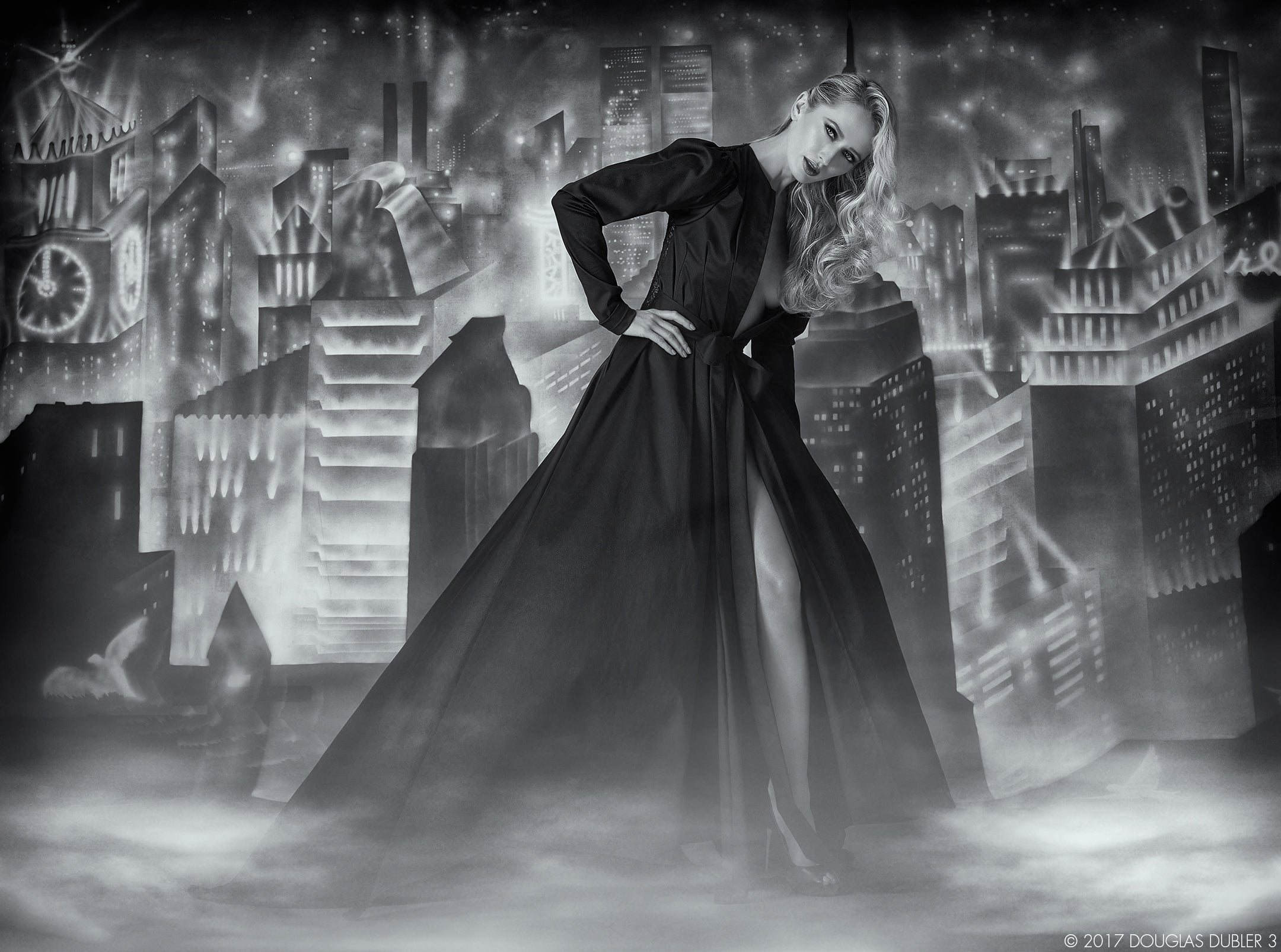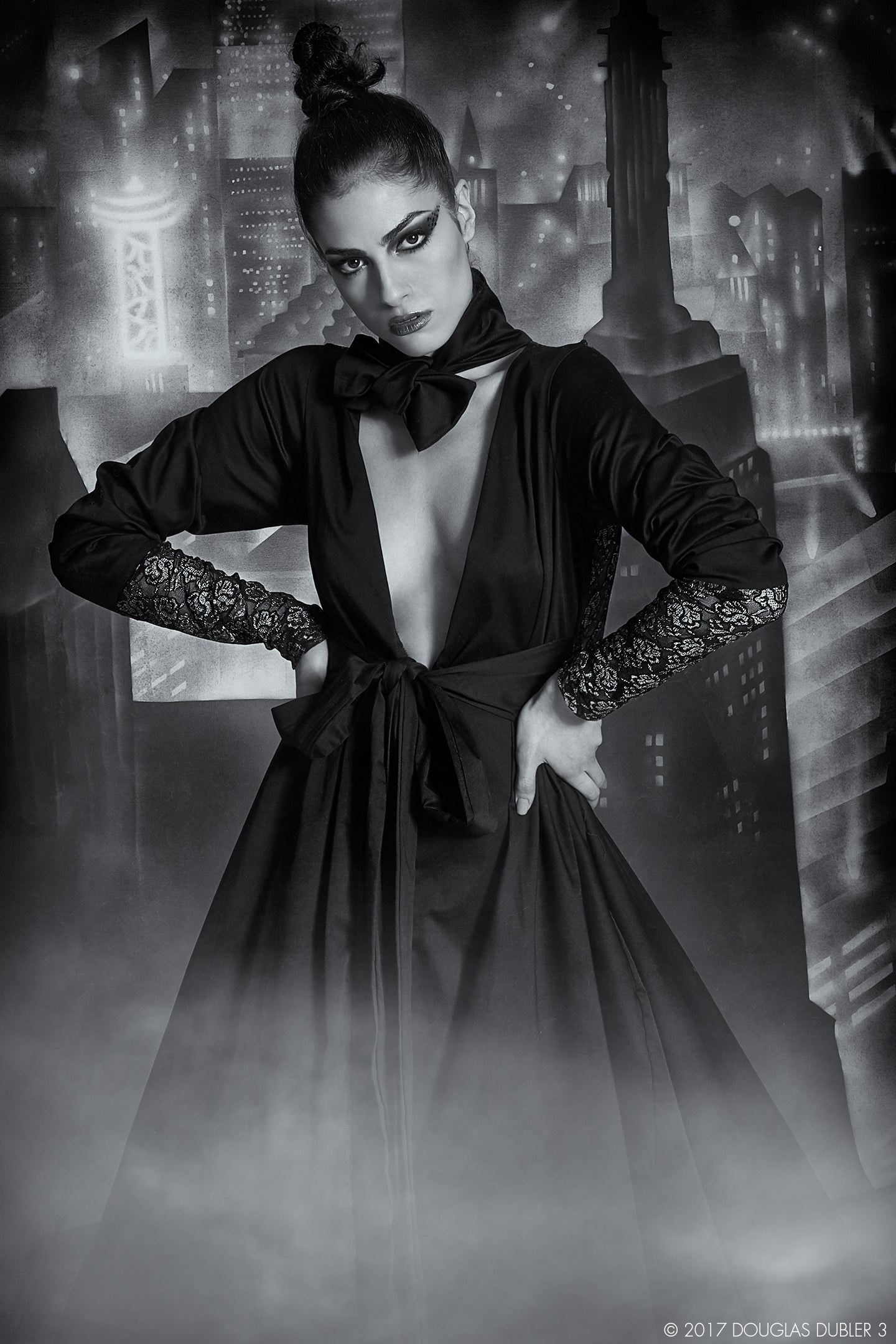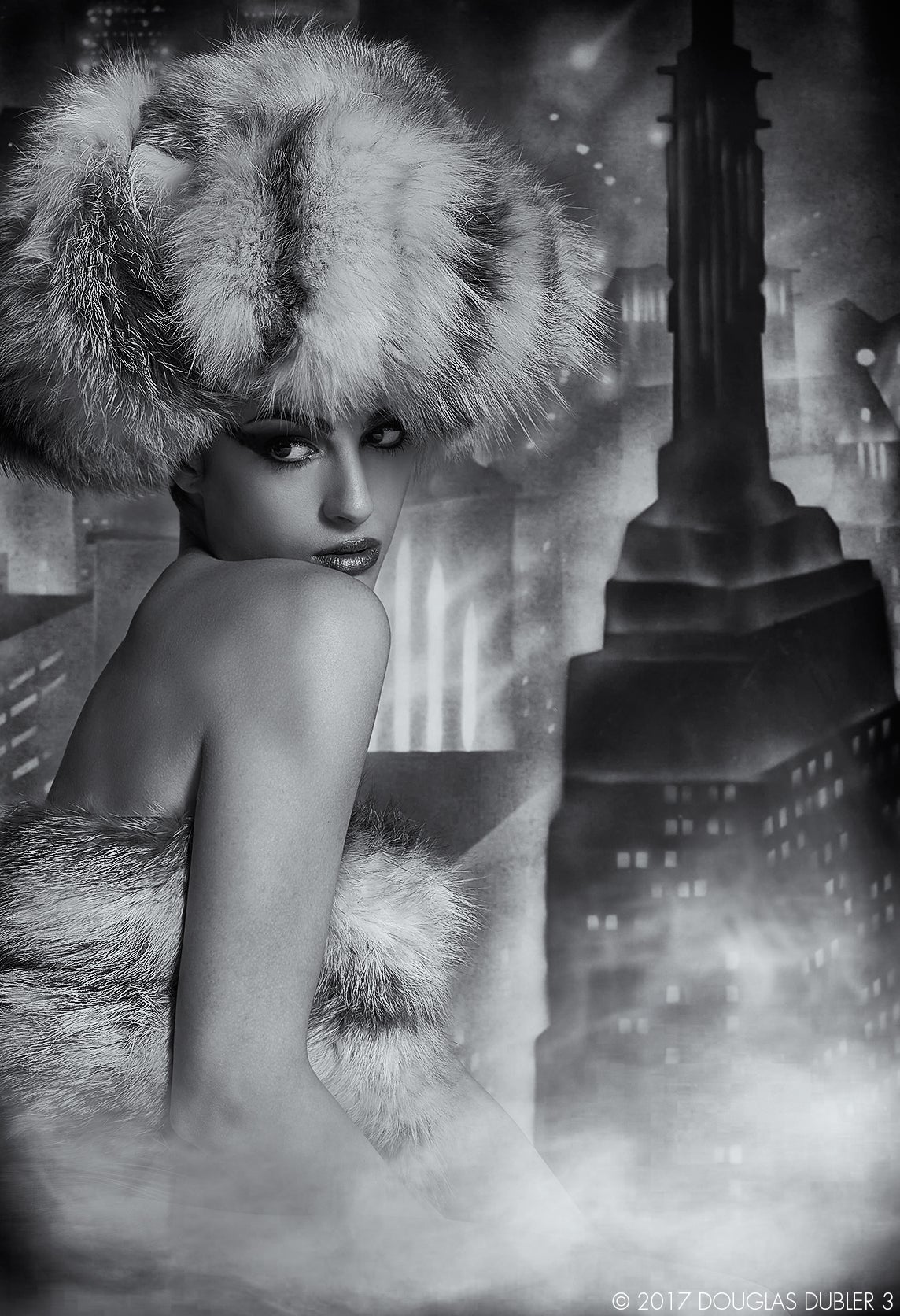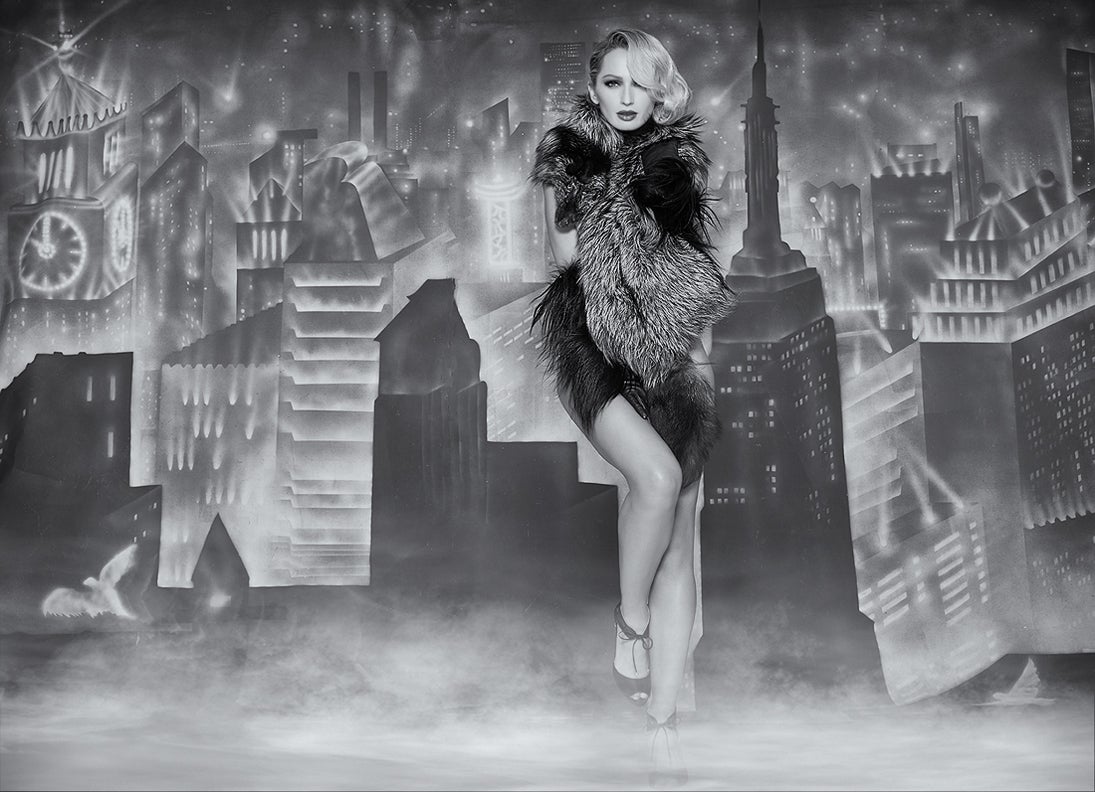Douglas Dubler is a veteran photographer who has been at the leading edge of high-concept fashion for decades. After experimenting with mirrorless cameras for a couple years, he recently made a full switch for an big editorial fashion shoot in New York for Driven Magazine. With more than a dozen staff; assistants, hair and makeup artists, designers and others on the set, it was a high-profile situation to be using the α7R II and α6500. Alpha Universe connected with Dubler to get all of the details and see if the cameras were up to the task (TLDR: they were).

Sony α7R II, Sony 55mm f/1.8 lens. 1/125-sec., f/11, ISO 100
Alpha Universe: You recently did an editorial fashion shoot with the α6500 and α7R II. How did that come together?
Douglas Dubler: It was actually my first big production shooting only with the mirrorless cameras. I took the α6500 and α7R II in there and tethered them to the computer. We had done plenty of tests before we went into the studio and based upon the results we decided that everything was a go. This was a typical large-scale production, which has been my trademark for many years. I had three models, and two hair and makeup artists, an additional hairstylist, a fashion designer, a magazine editor, digital tech and six or seven assistants. A lot of time, energy, and planning went into the shoot.
I couldn't have been happier with it. Almost everything worked flawlessly. In the studio, I shoot with one or two big 27 inch monitors, so I can see exactly what I'm getting. I look at the quality of the processed image before I start shooting for real. I had the digital tech process the files in Photoshop, and I looked at them in 16 bit and examined them quite closely at 100%.
The shoot itself went very, very smoothly. I did 12 shots, and I finished before six o'clock. I haven't done that many shots in one day in about 10 years. Part of that was just good planning coupled with a really good producer (Steve Titus). He directed the assistants and managed all of the logistics and technical details. But part of it was also that as is typical with my digital workflow, I just shot fewer pictures.

Sony α7R II, Sony 55mm f/1.8 lens. 1/125-sec., f/11, ISO 100
Alpha Universe: You said you shot fewer pictures yet a lot of photographers do exactly the opposite. Pixels are free so it’s easy and cheap to just shoot a ton of frames.
Douglas Dubler: Back in the film days, it wasn’t unusual for me to shoot 1,000 frames in a day with 120 film. That's about 100 rolls of film. When I started shooting digital, that went down. A typical day for me now may be 300 to 400 pictures, so a third of the capture. On this shoot I did 650. Digital capture is an efficient tool to work with if you can make up your mind. If you are indecisive you easily could end up with a lot of less than stellar images. If you can make up your mind, then, when it comes up on the monitor in the studio you look at it and say, "Okay. I'll tell the makeup artist to change this, the stylist to change that.” Then make the changes, shoot and evaluate and move on to the next shot. Working that way saves me a huge amount of time.
Time is money. But also, I like to move things along fast. When you beat it to death and shoot 500 pictures on one situation, it wears everybody out. Everybody loses their momentum. Most importantly, the model loses her momentum.
That doesn't mean that I'm not going to try different things. I just don't spend as much time on the first thing because I planned it and I was able to get that first shot in the can fast. In the space of time that someone working less efficiently might accomplish one thing, I've shot four situations.

Sony α6500, 35mm f/2 lens. 1/125-sec., f/11, ISO 100
Alpha Universe: Looking at these photos you did for the cover story in Driven magazine, they're really beautiful. How did you light everything?
Douglas Dubler: It all starts with the concept. For this shoot the concept was called “Gotham” which was inspired by Washington Irving's naming New York City “Gotham” in the 1800s. What I was thinking of was his infamous story The Legend of Sleepy Hollow with the Headless Horseman. It was this sense of dark foreboding, which seemed to me to fit with the fashion. I started with that. I then met with the fashion designer, Adrian Alicea and we came up with a concept and an approach. I have known Charles Broderson for 35 years, and his backdrops, those art deco backdrops of the skyline of New York City, were perfect for this. The backdrops were the cohesive element that focused and defined the concept. Last but not least executing that concept accurately would determine the success or failure of the shoot.
Typically I will build four or five “lights”, all on rolling stands, so I can change them quickly. The assistants tape the floor to indicate where each one should be placed along with the power pack settings and camera f/stop. For each shot I often look at several lights to determine which is most appropriate for the shot. Light is an expressive tool. I will often begin with my signature Broncolor LightBar 120’s which produce a flatter, diffused quality of light. That’s not to be confused with a softbox which I don’t like. I meter the background and foreground for exposure with a Sekonic L858 light meter and for color with Sekonic C-700 color meter. This technique eliminates color differences that would have to be solved in post by time consuming masking in Photoshop. My extremely attentive studio manager/producer and digital tech pay very close attention to these important details. We never say it can be fixed in Photoshop! It’s fixed in the camera.

Sony α7R II, 85mm lens. 1/125-sec., f/11, ISO 100
Additionally, I set up other sources that produce progressively higher contrast light. At the other end of the spectrum is my Pulso Spot with a Fresnel lens which produces the highest contrast of the group. But in fact, the majority of the shots in this shoot were done with the Focus 110 Broncolor umbrella which is a parabolic umbrella that permits focusing of the beam. It was the first time I had used this relatively new light modifier from Broncolor. Obviously I liked it.
I often mix continuous light with strobe light. Very often, I'll do the backgrounds with continuous light. I'm starting to use some LED sources now. The last few years, I haven't cared for the color of the LEDs, but now Mole-Richardson makes LED devices with better color balance that seem to be the future of continuous light. Previous to that, I was using HMIs, which were a lot easier to color balance but very, very, very hot and hard to work with. Everybody has to have gloves to gel them, and the gels will burn up if you get them too close to the heads. The LEDs are much easier to work with.
For electronic flash, I only use Broncolor. I've been using Broncolor exclusively for more than 40 years, and they're always innovating and coming out with new tools. That's my lighting of choice.

Sony α7R II, Sony 55mm f/1.8 lens. 1/125-sec., f/11, ISO 100
Alpha Universe: How do you set up the camera when you're doing a fashion shoot like this?
Douglas Dubler: If I'm shooting the clothes, I want the clothes to be pretty sharp, so I'm going to shoot at f/11 to give me that depth of field. If I'm coming in tight and I'm doing beauty and I don't care about showing the fashion that much, then I might open it up a little bit to f/5.6 or f/8.
Generally, I don't shoot at less than f/5.6 because I want to hold sharpness in both eyes. That's the good thing about decades of experience. A lot of this stuff, you just know from experience exactly what your approach is going to be. I still experiment and try different things, but I can rule out a lot of the variables that I don't think are going to work based upon my experience.
For the cameras, in the studio, all exposure settings are on manual. I have the focus peaking on, and I'm using it in autofocus mode. The autofocusing with the α6500 and the α7R II is very, very accurate. I'm always having the digital tech check the focus in the Capture One software. In Capture One, you can use the focus enlargement tool. The digital tech checks focus periodically as I shoot and lets me know if I'm front or back focused. That's what he says, front or back or nothing if it’s right on. I want those pictures to be sharp all the time. I want them to be where I focused. I have found, with the mirrorless technology, since I'm focusing right on the sensor, I can see that in the viewfinder.
I keep Picture Setting Effect on so when I’m looking in the viewfinder, I’m seeing everything at the aperture that I'm shooting at. I'm seeing exactly what I'm going to get on the capture. That saves a lot of what I used to have to do with the DSLR, shoot and then look at the picture. I find the mirrorless cameras are so much better than Live View in the DSLR because I don't have to deal with the noise and focus lag of the DSLR.
What lenses did you use for this shoot?
For me the lens is a very important part of the system. Early in my career, I was an advocate of apochromatic (APO) lenses which were the sharpest lenses made at the time. I would also often use lenses that were meant to cover a larger format on smaller format cameras so I could work with the center resolution of the lens. I’m usually not a fan of zoom lenses and I don’t own any. For this shoot I used 35, 55 and 85mm prime lenses.
The Sony 55mm f/1.8 in particular is one of my favorite lenses. Several years ago, when I first got some Sony lenses and cameras to evaluate, the 55mm immediately became my favorite of the lot for its incredible sharpness. I used the Sony 55mm f/1.8 on the α7R II and I used the α6500 with full-frame lenses for several images on the Gotham shoot. I also shot with the manual-focus-only Otus 85mm f/1.4 which I’ve owned for several years. At $4500 it’s one of the most expensive lenses I’ve ever owned and it performed spectacularly on the α7R II as expected.
So you were using the α6500 with the full frame lenses for several images?
As I mentioned, in the past I have often used this formula of using a lens designed for a larger format on a smaller one. Pretty much any lens performs strongest in the center and weakest toward the edge of the image circle. Using the full frame lens on the APS-C sensor means I'm using the very best part of the lens. It eliminates peripheral sharpness, vignetting and distortion issues. Any small amount of chromatic aberration can be eliminated in Capture One software which is my preferred software for processing all of my raw files. In addition, I get an increase in depth of field due to the smaller sensor. Those are all big pluses for me. So much so that the α6500 and 55mm f/1.8 has become my “carry” combination. Like my American Express card I don’t leave home without it.

Sony α6500, 35mm f/2 lens. 1/125-sec., f/11, ISO 100
Alpha Universe: What prompted your decision to do the shoot in black & white?
Going back to the original concept of “Gotham”, my imagination then clicked on the neo-noir science fiction classic, Blade Runner. Charles Broderson’s evocative backdrop of the New York skyline could easily be from the film’s set. Combined with the look and predominance of color black in the garments, black & white was the logical choice. My conversion technique using Nik Silver Efex Pro involves three passes with the software giving me tonal separation. That adds a more three-dimensional feeling to the images. Having started my art career as a sculptor, I am always trying to bring that third dimension into a two dimensional art form.
Alpha Universe: What is your ultimate objective when you're producing such a challenging shoot ?
Douglas Dubler: Regardless of the client or job my focus is always on making files for fine art printing. There is little challenge for me in producing files for electronic viewing. The small color space (sRGB) can’t compare to the ProPhoto files that I send to the Epson printer. I routinely print 40”X60” and larger. At those sizes, any defect in the file ( noise, digital artifacts, etc. ) screams out at you. In this context I am always working for myself. The printed images will be my legacy and that's very important to me.

Sony α7R II, Sony 55mm f/1.8 lens. 1/125-sec., f/11, ISO 100
"GOTHAM" Shoot Credits:
Photography/Creative Direction by Douglas Dubler 3 www.douglasdubler3.com @douglasdubler, FB:douglas.dubler
Fashion: Adrian Alicea: Adrianalicea30@gmail.com @iamadrianalicea
Models: Rachelle Di Stasio: One Management, @rachelledistasio
Nadia Kazakova : www.nadiakazakova.com,@nadiakazakova
Makeup Nadia: Sylvia Pichler @sylvia_makeuprules
Makeup Rachelle: Claudia Rodrigues: klaudiamakeup.com
Hair: Anthony Isambert www.thedrivenmagazine.com
Retouching: Irfan Yonac: yonacretouching.com
Backdrops: Charles Broderson: brodersonbackdrops.com
Studio: Go Studios: info@go-studios.com
Lighting: Broncolor ,www.bron.ch/broncolor/
Producer: Steven Titus
1st Assistant: Brent Eysler



